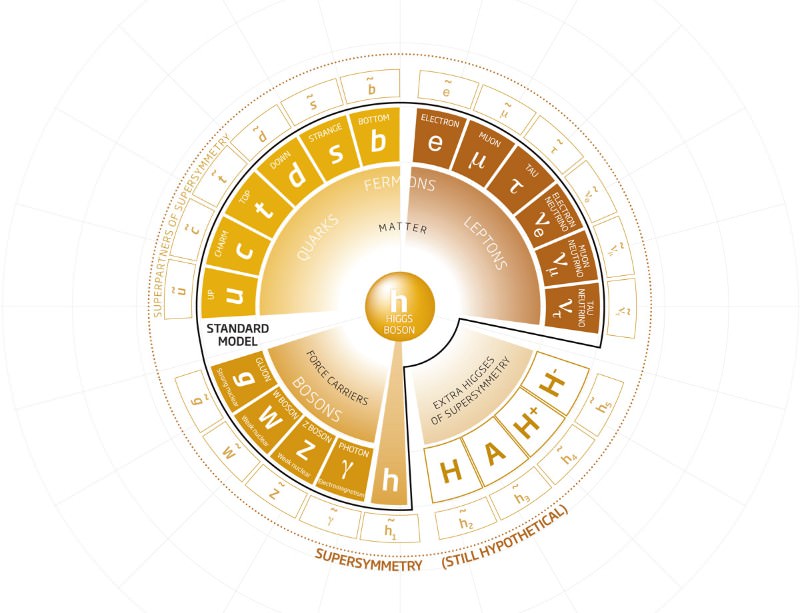Supersymmetry
Supersymmetry is the postulated existence of one-to-one correspondence between fundamental fermions and fundamental bosons as predicted by string theory. This proposed symmetry has not been observed, but could hold true at higher energies than presently observable. [2] [3] Supersymmetry acts as an expansion of the standard model of particle physics. The discovery of the higgs boson in 2012 completed the standard model, but it still leaves some questions unanswered. Supersymmetry aims to fill gaps left by the standard model and explain the phenomena of particle interactions. [1]
Implications
Supersymmetry would more than double the number of standard model particles because it requires each known particle, as well as a few undiscovered ones, to have a superpartner (shown in the outer ring of the diagram below). Supersymmetry may provide a means for unifying the strong and weak nuclear forces in addition to yielding explanations for the existence and composition of dark matter. [1] [2]
Applications
The way tiny particles interact have extremely large-scale ramifications, such as our understanding of how certain natural phenomena such as black holes and galaxies exist as they do. For instance, gravity may appear to be a simple concept, but it actually would require supersymmetry or a similar expansion upon the standard model in order to acquire a solid explanation. [5] Proof of supersymmetry would likely not be applicable to daily life in any way, however, it would shape our understanding of both particle and astrophysics, and determine the path of future scientific questions.
History
Hironari Miyazawa was the first person to propose supersymmetry, in a theory relating mesons and baryons. Because of how broken his symmetry was, his work was largely ignored. Two groups of scientists all independently began working on a supersymmetry in quantum field theory around the same time, J. L. Gervais and B. Sakita(1971), Yu. A. Golfand and E. P. Likhtman(1971), and D. V. Volkov and V. P. Akulov(1972). The Gervais-Sakita works arose because of an early version of string theory. The model proposed by Pierre Fayet, known as the Minimal Supersymmetric Standard Model, was the first realistic model in superstring theory proposed.[1] [3] [4]
See also
Einstein's Theory of General Relativity
Elementary Particles and Particle Physics Theory
External Sources and Links
[1] "New Particle, New Questions," NewScientist, ed. July 14, 2012.
[1] Introduction to Supersymmetry by Hitoshi Murayama
[2] String Theory and Supersymmetry for Dummies
[3] Supersymmetry by Christine Sutton
[5] The Quantum Universe (pp. 196-207) by Brian Cox and Jeff Forshaw
References
"New Particle, New Questions," NewScientist, ed. July 14, 2012.
https://en.wikipedia.org/wiki/Supersymmetry
http://hitoshi.berkeley.edu/public_html/susy/susy.html
http://www.britannica.com/science/supersymmetry
http://www.dummies.com/how-to/content/string-theory-the-history-of-supersymmetry.html
The Quantum Universe (pp. 196-207) by Brian Cox and Jeff Foresaw
